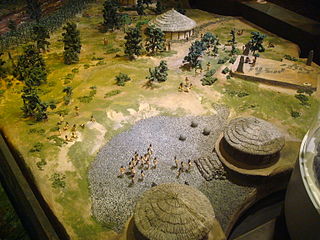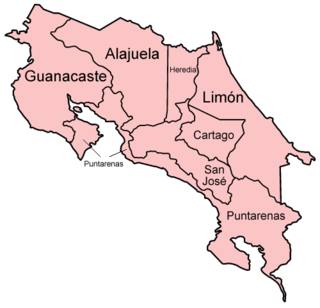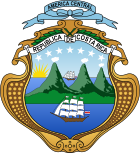
Costa Rica, officially the Republic of Costa Rica, is a country in the Central American region of North America. Costa Rica is bordered by Nicaragua to the north, the Caribbean Sea to the northeast, Panama to the southeast, and the Pacific Ocean to the southwest, as well as maritime border with Ecuador to the south of Cocos Island. It has a population of around five million in a land area of 51,060 km2 (19,710 sq mi). An estimated 333,980 people live in the capital and largest city, San José, with around two million people in the surrounding metropolitan area.

The first indigenous peoples of Costa Rica were hunters and gatherers, and when the Spanish conquerors arrived, Costa Rica was divided in two distinct cultural areas due to its geographical location in the Intermediate Area, between Mesoamerican and the Andean cultures, with influences of both cultures.

Costa Rica is an active member of the international community and, in 1983, claimed it was for neutrality. Due to certain powerful constituencies favoring its methods, it has a weight in world affairs far beyond its size. The country lobbied aggressively for the establishment of the Office of the United Nations High Commissioner for Human Rights and became the first nation to recognize the jurisdiction of the Inter-American Human Rights Court, based in San José.

San José is the capital and largest city of Costa Rica, and the capital of the province of the same name. It is in the center of the country, in the mid-west of the Central Valley, within San José Canton. San José is Costa Rica's seat of national government, focal point of political and economic activity, and major transportation hub. San José Canton's population was 288,054 in 2011, and San José's municipal land area is 44.2 square kilometers, with an estimated 333,980 residents in 2015. Together with several other cantons of the central valley, including Alajuela, Heredia and Cartago, it forms the country's Greater Metropolitan Area, with an estimated population of over 2 million in 2017. The city is named in honor of Joseph of Nazareth.

According to Article 168 of the Constitution of Costa Rica, the political divisions are officially classified into 3 tiers of sub-national entities.

Liberia is a district and the largest city in the Guanacaste Province of Costa Rica, located 215 kilometres (134 mi) northwest of the national capital, San José. Part of the Liberia canton, it is a major center for the country's tourism industry.

Education in Costa Rica is divided in 3 cycles: pre-education, primary education, and secondary school, which leads to higher education. School year starts between the second and third week of February, stops at the last week of June, it continues again between the third and fourth week of July and finishes between the last week of November and the second week of December. Preschool and basic education are free to the public. Elementary and secondary school are both divided in two cycles. Since 1869, education is free and compulsory.

Costa Rica is administratively divided into seven provinces which are subdivided into 84 cantons, and these are further subdivided into districts. Cantons are the only administrative division in Costa Rica that possess local government in the form of municipalities. Each municipality has its own mayor and several representatives, all of them chosen via municipal elections every four years.

Dice's cottontail is a species of cottontail rabbit in the family Leporidae. It is found in Costa Rica and Panama, in páramo and cloud forest habitats.

Costa Rica first participated at the Olympic Games in 1936, but then missed the next four Olympiads. The nation returned to the Games in 1964, and has participated in every Summer Olympic Games since then. Costa Rica has also participated in several Winter Olympic Games since 1980.

The following outline is provided as an overview of and topical guide to Costa Rica:
The history of the Jews in Costa Rica dates back to the Spanish conquest with the arrival of many Sephardic converts known as Marranos who escaped from the Spanish Inquisition and settled mainly in the city of Cartago and its surroundings. They hid their Jewish past by all means, making even their descendants have no idea of it.

The Costa Rica women's national football team represents Costa Rica in women's international football. The national team is controlled by the governing body Costa Rican Football Federation. They are one of the top women's national football teams in the Central American region along with Guatemala and Panama.
Reinas de Costa Rica is a national beauty pageant in Costa Rica that selects representatives to the Miss World and Miss International pageant. After the Miss Costa Rica pageant stopped sending contestants to the Miss World and Miss International pageants in 2006, the franchise was acquired by the Reinas de Costa Rica organization presided by Alan Aleman. However, after two years of absence in the Miss World pageant in 2017-2018, the organization eventually lost the franchise to the newly established contest, Concurso Nacional de Belleza de Costa Rica, in 2019. The organization also lost the Miss Earth franchise to Jose Vásconez in 2016.

According to the Territorial Administrative Division, the cantons of Costa Rica are subdivided into 488 districts (distritos), each of which has a unique five-digit postal code.

The First Costa Rican Republic is the name given to the historical period between the proclamation of the Republic of Costa Rica in the 1848 reformed Constitution and the official decree by then President José María Castro Madriz on 31 August 1848 and the Costa Rican Civil War of 1948 which ended with the enactment of the current 1949 Constitution on 7 November 1949 starting the Second Costa Rican Republic.

Cinema of Costa Rica refers to the film industry based in Costa Rica. The Costa Rican cinema comprises the art of film and creative movies made within the nation of Costa Rica or by Costa Rican filmmakers abroad.
Antisemitism in Costa Rica refers to the anti-Jewish sentiment and prejudice in the Republic of Costa Rica.














